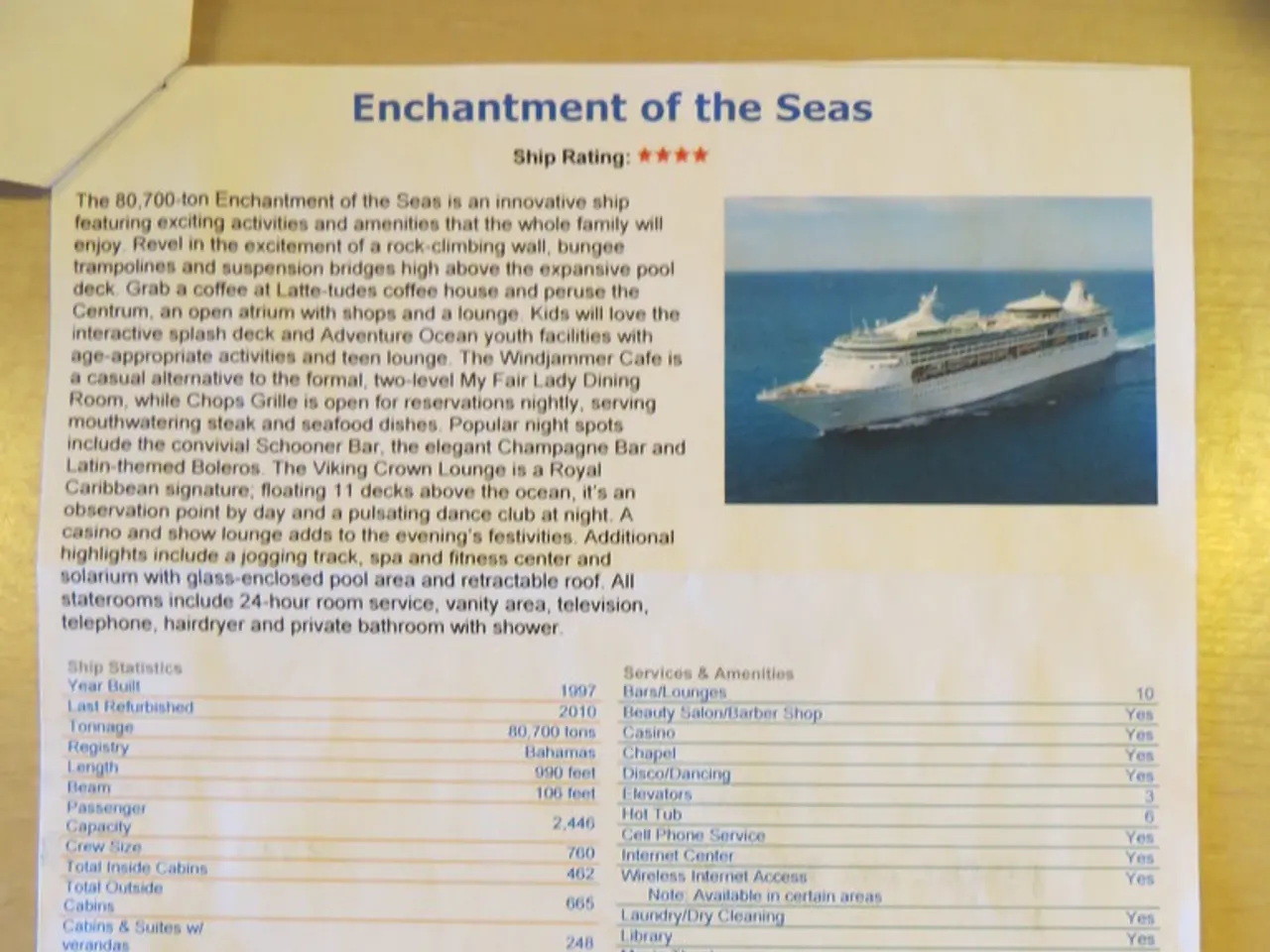International Cooperation on Transboundary Charting Discussions Enhanced through Technological Assistance by the Hydrographic Geospatial Products and Services Committee (HGPSC) between the United States and Canada
US-Canada Collaboration Ensures Safe Navigation in Shared Waters
The United States and Canada have a long-standing history of collaboration in managing maritime charting, primarily through the United States-Canada Hydrographic Commission (USCHC) and specialized advisory groups like the Chart Advisors Committee (CAC). This cooperative framework supports harmonized hydrographic surveying and nautical chart production to ensure safe navigation across shared waters, especially in the Great Lakes and coastal areas.
Historical Background
The USCHC was established in April 1977, following decades of formal hydrographic survey and charting collaborative programs. The U.S. Lake Survey, established in the 19th century, was among the earliest federal efforts focused on hydrographic surveying of the Great Lakes to support navigation and commerce. It has evolved alongside Canadian efforts to chart shared waterways.
The USCHC's mission includes harmonizing standards, exchanging hydrographic data, and jointly addressing shared nautical charting challenges. Within the USCHC, the CAC functions as a technical advisory group that reviews charting priorities, standards, and operational issues related to hydrographic data and chart production. Canadian Hydrographic Service (CHS) Charting Advisors collaborate closely with their U.S. counterparts, exchanging expertise and updates for accuracy and consistency in charts covering binational waters.
Current Status
NOAA and CHS remain actively engaged in updating nautical charts and associated hydrographic data cooperatively. Hydrographic surveys are carried out jointly or shared through integrated databases, assuring consistency of chart information across the border.
NOAA’s nautical charts incorporate standards like Zone of Confidence (ZOC) diagrams and CATZOC (Category of Zone of Confidence) data, which reflect hydrographic survey quality and are utilized in both U.S. Electronic Navigational Charts (ENCs) and Canadian products to maintain interoperable safety information.
The USCHC through the CAC and related working groups continues to oversee coordination of survey priorities, technical standards, and operational collaboration. This ensures harmonized approaches to chart production and update schedules in shared maritime zones, including the Great Lakes, Saint Lawrence Seaway, and border coastal waters.
The Transboundary Web App
The USCHC Transboundary Web App can be accessed at https://noaa.maps.arcgis.com/apps/webappviewer/index.html?id=3d56cca277334bb18d918e4292bd3313 (accessed 17 Sep. 2023). This tool allows for easier analysis, visualization, decision-making, and documentation of decisions related to charting in shared waters.
Collaborative Efforts
Notable collaborative efforts include the construction of the St. Lawrence Seaway, which led to the establishment of a primary first-order horizontal ground control, an internationally agreed upon vertical control datum, methods to regulate and monitor the hydraulics of the waterway, and the construction of navigational charts before the opening of the seaway.
The Bay of Fundy necessitated a single producer for the largest scale charts due to its complexity. Single-agency solutions are employed in areas where the waterway is narrow or navigational fairways are aligned to the boundary. In areas transitioning from a CATCOV to a single-agency solution, a hybrid, single-case approach is used.
Recent collaborative efforts include re-negotiations of transboundary areas because each hydrographic office was working towards rescheming their ENC coverage into a fixed grid of rectangular cells to support S-100 products. In 2018, the CAC was rebranded as the Hydrographic Geospatial Products and Services Committee. NOAA has set up a shared space on Google Drive accessible to US and Canadian personnel for real-time collaboration.
Moving Forward
The USCHC holds meetings with regional production branches for each charting agency to discuss chart rescheming projects. In 2011 and 2012, representatives from the two nations drafted several addendums to the overarching Memorandum of Agreement, documenting which electronic navigational charts would be cut and which country would be responsible for maintaining them. The decision to split each transboundary cell's CATCOV into "coverage available" and "no coverage available" along the international boundary was made, with the area encoded as "no coverage available" having no chart data.
This coordinated framework reflects decades of bilateral efforts to maintain navigational safety and promote efficient hydrographic data use in shared waters. While there is no singular historical document in the search results explicitly narrating the entire history of the USCHC or CAC, their roles and collaborative functions are strongly implicated in NOAA’s and CHS’s modern charting operations and published standards.
[1] NOAA. (n.d.). United States-Canada Hydrographic Commission (USCHC). Retrieved September 17, 2023, from https://www.nauticalcharts.noaa.gov/uchc/
[2] Canadian Hydrographic Service. (n.d.). Canadian Hydrographic Service Charting Advisors. Retrieved September 17, 2023, from https://www.charts.gc.ca/eng/index.asp
[3] NOAA. (n.d.). Zone of Confidence (ZOC) and CATZOC Data. Retrieved September 17, 2023, from https://www.nauticalcharts.noaa.gov/uchc/zoc/
- In environmental science, studies on climate-change impacts often require hydrographic survey data to analyze changes in water bodies.
- For personal-finance management, understanding how changes in climate-change policies might affect real-estate investments is a growing concern for investors in home-and-garden.
- Technology advancements in data-and-cloud-computing are enabling more efficient hydrographic surveys, thereby streamlining the process of creating nautical charts for business and sports, such as NBA games and NCAA basketball tournaments.
- The USCHC's collaboration has facilitated the creation of the Transboundary Web App, a tool beneficial to many lifestyle choices, including travel itineraries and outdoor recreational activities.
- Financing for the USCHC relies on thorough budgeting and strategic planning, ensuring that taxpayers' money is spent wisely and that their interests are protected.
- The updated nautical charts produced by the USCHC and CHS are essential for the safety and efficiency of fleet operations in the maritime industry, impacting business outcomes and bottom lines.
- The USCHC's historical background in science and hydrographic surveying has set precedents for other fields, such as the development of more accurate weather forecasting models and advancements in data-and-cloud-computing technology.
- The collaboration between the USCHC and CHS showcases the importance of international cooperation in addressing complex issues, such as climate-change impacts on shared water bodies and the need for harmonized approaches to chart production and update schedules in shared maritime zones.




